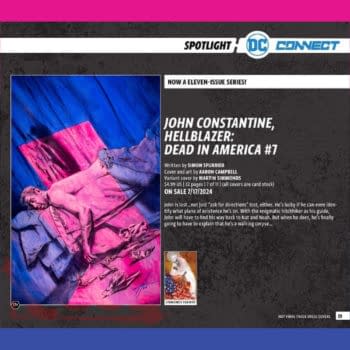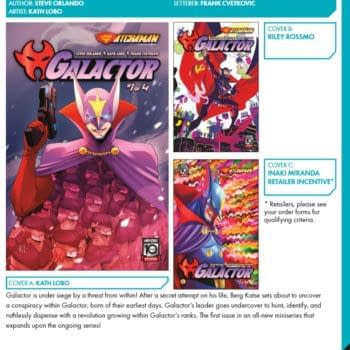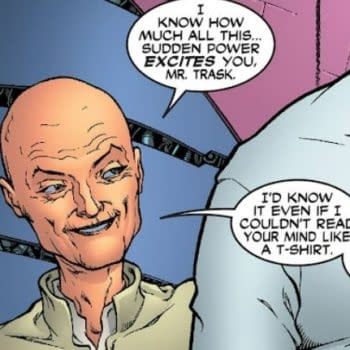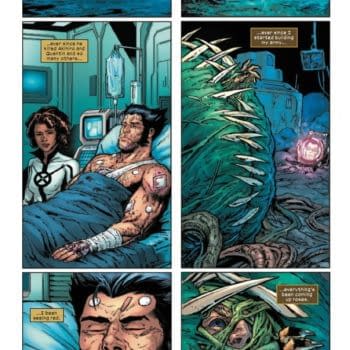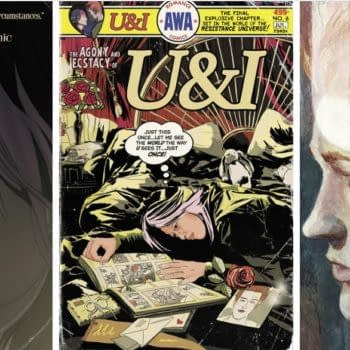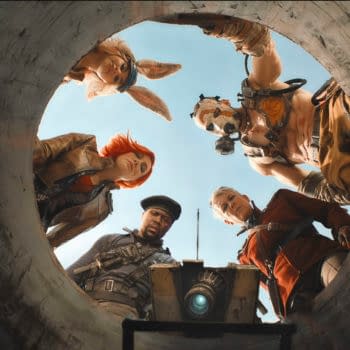Posted in: Comics, Recent Updates | Tagged: Comics, conan, dark horse, dynamite, entertainment, five ghosts, Frank Barbiere, Heroes Con 2014, image, Joe Rauch, lobster johnson, Solar: Man Of The Atom, Tim Truman, Wilfredo Torres
Pulp Comics Are An Art Gallery On Fire – Wilfredo Torres, Frank Barbiere, And Tim Truman At Heroes Con
"Pulp Goodness" was another great choice for a Sunday panel at Heroes Con, with a wide range of creators working with legacy and new characters, and determining how to navigate influence and research while bringing in their own voices as dedicated to pulp tradition. Joe Rauch hosted Wilfredo Torres (The Shadow, Lobster Johnson), Tim Truman (Conan), and Frank Barbiere (Five Ghosts, Solar) in discussion.
Frank Barbiere said that pulp tradition is largely the "aesthetic" of Five Ghosts and said, "It's amazing what aesthetics can do in terms of reception". It also helps to bring a "unifying theme" of pulp under a large umbrella. It helps the team stand out with an aesthetic that people don't often use to generate entirely new material that doesn't necessarily "fit in perfectly" to pulp tradition. He credited artist Chris Mooneyham with pulling this off and also influencing the story and making pulp homage organic to the storytelling. In being "old, it becomes new again", he said. A similar pattern can be found in noir and crime homage, creating a new "mash up of genres", giving a "hint of the familiar" to readers in the best way.
Wilfredo Torres spoke about Lobster Johnson, a character who Mike Mignola loves, and said anyone who expects an origin story, expounding on the past, is not likely to get it. Torres also works on The Shadow, and said it's very much "year one" without a lot of back story, which keeps it fresh. He wanted the Shadow to be "old Hollywood" in style and wanted to have the "split" between furs, pearls, and tuxedo as well as the "backroom feel" that was, in effect, kind of "dirty" and a seedy underbelly.
Barbiere commented that not having to explain the hero is something he likes from pulps and has picked up. Like in Indiana Jones, he doesn't talk that much. Torres agreed, and said it's hard to do to present a hero "fully formed" and get the reader to simply accept it. Barbiere added that it takes a strong artist to do that.
Rauch observed that the panelists seem to work with characters who seem "on the surface straightforward" and yet manage to make the characters "last" as being more complex than they may seem at first. Truman said it's very easy to "pigeonhole" Conan in that way and it takes realizing that there's "more to him" than hack and slash, drinking, and women. The best way he's found to "encapsulate" Conan is that he realized after reading a scholar's thesis on the subject, that you have to understand that Conan is a "wolf" and whatever a wolf is attracted to, he is attracted to. Once others are accepted within his "pack", he does whatever he can to protect them, with a "definite sense" of trust and distrust.
Barbiere and Truman commented on the cartoon version of Conan that doesn't necessarily get Howard's vision right, where Conan does have a "fear aspect" in religious and magical terms. Rauch brought up the strong personal "moral compasses" with a clear sense of rights and avenging wrongs and asked if that's necessary to make stories work as pulp. Truman agreed that for heroes that strong characterization is necessary, but usually the villains have their "sense of ethics as well". When you read pulp characters like Dashiel Hammett and Raymond Chandler, they are complex, and don't want their assignments, but get drawn into "webs" and end up being "flawed heroes".
Barbiere speculated that "post-Millenial" comics feel the need to be "needlessly complicated" and that leads to audiences identifying pulp heroes as overly simple, and in Five Ghosts it's clear "who wants what", but still feels that label is misused. He sticks to driving forces in the comic but doesn't allow them to become a "button push" that switches an ambiguous character to a hero just because of one good deed.
Barbiere navigates between "quest of the week" storylines in Five Ghosts, but the comic doesn't have a lot of narration, which allows the character to speak through his actions, which allows "incremental change" in the character. Since Barbiere letters the comic, he often removes dialogue once he sees Mooneyham's art and the strength of context it conveys, allowing less explication. In a recent issue, they have 6 or 7 pages with no dialogue on a desert island, and reading through action is a more "rewarding" experience from Barbiere's perspective. It avoids "needless complication" and he pulls away from having too many "B stories" alongside the main narrative. Serialized, episodic comics in the old days needed more of that catching up on plot and motivation that's no longer necessary.
Rauch brought up the "expressiveness" necessary in pulps, and asked Torres how they convey The Shadow's intensity using only his eyes. Torres went for "crazed looks" and worked with eyes a lot, and "You'd be surprised how much you can do with that", he said. He does a lot with mirrors to get eye expression, adds body posture, tilt of the head. Codes create characters who "cant walk away" from things, he added, and he said that's complex, rather than simple. He also thinks that people underestimate "how hard it is to make things simple" or appear simple in a story, where you have to start "subtracting" and editing oneself. All of the panelists agreed that "boiling down" a pitch is very difficult and manage to avoid a Game of Thrones complexity.
Barbiere feels we're losing a lot of that "mythology" by uselessly complicating things. Truman explained about Conan that trying to analyze the character while action is underway is unhelpful, but rather when you're "off the ride" later. Torres agreed that it's about "telling the story", not creating an "art gallery". It's more like "You walked into an art gallery that's on fire, running past beautiful paintings to get to the end", and his job is to get readers in the door and outside as quickly as possible, allowing them to think about the beauty later.
An audience member finally asked the tough question about how the panelists would define "Pulp" broadly. Torres said he wouldn't marginalize it by genre, but more by approach. Truman said that pulp is "working man's fiction" for people who might be able to afford 10 cents, at a time when people were paying to go to movies or buying a pulp once a month. It wasn't an "elite fiction" as entertainment to forget about the troubles in their lives as escapist fiction "written for them". Truman said another thesis helped him understand by stating that before detective stories, mysteries were written "for the elite" with aristocratic characters. Even many of the Sherlock Holmes stories are "on that level", Truman said. Chandler and Hammett introduces the "problems of the working class" at "street level". Robert Howard got away from Lord Dunsany fantasies dealing with kings and queens, Truman observed. That's the "one thing" to understand about pulp, he said, the "street level".
Barbiere feels that in comics there always has been a "fear" of embracing genre. For him, pulps are about "beautiful simplicity" and knowing what makes genres work. He just did a pirate arc on Five Ghosts and has them speaking as he thinks pirates speak with is a little "cartoony" but it works within that world and "embraces" what is "fun" about those genres.
Rauch noticed that in Five Ghosts, Barbiere brings in elements of the far East with a "dramatic change in language and tone" but doesn't incorporate the negative legacies and "offensive issues" that don't meet with our standards these days. Barbiere said there's a "line" and he can find a diplomatic way to present diversity without being offensive despite pulp tradition. The Spider-god elements in Five Ghost's first arc did offend some people, who asked why they didn't "subvert" it, but when doing homage you can censor yourself, and he's happy with the result. Adding female characters in the second arc, such as a female pirate who could channel the ghost of a male hero (Sinbad), helped expand the cast of the book, and he feels that once you start putting "labels" on things people will start having preconceived notions of how diversity should be handled.
In adapting Conan books, Truman confronts a lot of "patronizing" pulp tradition, particularly in Native American material, and takes a close look at how he handles telling old stories in new ways.
A fan asked whether there's a particular reason behind particular aesthetics of pulp tradition right now. Torres commented that there is much digital creation this days too in the "inking". There's the very noir, chalky, deep black look, Torres said, and that's "the best way to communicate quickly to someone" that they are in the pulp tradition. Someone like Francesco Francavilla, Torres said, is a master of removing elements to highlight simplicity and many good pulp creators highlight "fun" and "grand adventure" in this way. Alex Toth was heavily name-checked by Barbiere and Torres as an influence on artists, now available in large IDW editions, keeping stylistic impact alive. Plenty of people don't realize how hard it is for someone to create the simplicity involved in presentation, and is only reached through "experimenting through the language" of comics and noir and pulp are also a "language", Torres said.
Torres has been working on Quantum & Woody, has a Batman '66 coming out in September. Truman has a new King Conan coming out, and he and his son are doing something with the "Scout" character. Barbiere is working on Five Ghosts from Image Comics, Solar: Man of the Adam at Dynamite, and other projects too.













